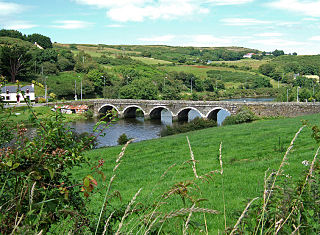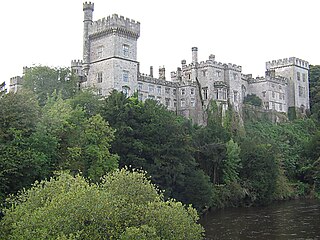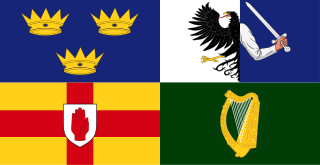
The Great Famine, also known within Ireland as the Great Hunger or simply the Famine and outside Ireland as the Irish Potato Famine, was a period of starvation and disease in Ireland lasting from 1845 to 1852 that constituted a historical social crisis and subsequently had a major impact on Irish society and history as a whole. The most severely affected areas were in the western and southern parts of Ireland—where the Irish language was dominant—and hence the period was contemporaneously known in Irish as an Drochshaol, which literally translates to "the bad life" and loosely translates to "the hard times". The worst year of the famine was 1847, which became known as "Black '47". During the Great Hunger, roughly 1 million people died and more than 1 million more fled the country, causing the country's population to fall by 20–25% between 1841 and 1871. Between 1845 and 1855, at least 2.1 million people left Ireland, primarily on packet ships but also on steamboats and barques—one of the greatest exoduses from a single island in history.

The legacy of the Great Famine in Ireland followed a catastrophic period of Irish history between 1845 and 1852 during which time the population of Ireland was reduced by 50 percent.

Skibbereen is a town in County Cork, Ireland. It is located in West Cork on the N71 national secondary road. The River Ilen runs through the town; it reaches the sea about 12 kilometres away, at the seaside village of Baltimore. As of the 2011 Irish census, the population of the town was 2,568. The town of Skibbereen, sometimes shortened to "Skibb", is in the Cork South-West Dáil constituency, which has three seats.

Lismore is a historic town in County Waterford, in the province of Munster, Ireland. Originally associated with Saint Mochuda of Lismore, who founded Lismore Abbey in the 7th century, the town developed around the medieval Lismore Castle. As of the 21st century, Lismore supports a rural catchment area, and was designated as a "district service centre" in Waterford County Council's 2011–2017 development plan. As of 2022, the town had a population of 1,347 people.

The Holodomor, also known as the Great Ukrainian Famine, was a man-made famine in Soviet Ukraine from 1932 to 1933 that killed millions of Ukrainians. The Holodomor was part of the wider Soviet famine of 1930–1933 which affected the major grain-producing areas of the Soviet Union.

Ennistymon or Ennistimon is a country market town in County Clare, near the west coast of Ireland. The River Inagh, with its small rapids known as the Cascades, runs through the town, behind the main street. A bridge across the river leads to nearby Lahinch, on the N67 national secondary road. The town is connected to Ennis by the N85, continuing the settlement's main street.

The Irish Hunger Memorial is a 0.5-acre (0.20 ha) park at the corner of Vesey Street and North End Avenue in the Battery Park City neighborhood of Manhattan in New York City. The memorial is dedicated to raising awareness of the Great Irish Hunger, referred to as An Gorta Mór in Irish, in which over one million starved to death between 1845 and 1852. In the decade after 1845, over 900,000 Irish emigrants entered the port of New York so that by 1855 Irish-born New Yorkers comprised almost one third of the city's population.
Ballygar is a village in County Galway, Ireland. It is 19 km from Roscommon town.

Penn's Landing is a waterfront area of Center City Philadelphia, Pennsylvania, United States, situated along the Delaware River. Its name commemorates the landing of William Penn, the founder of Pennsylvania, in 1682. The actual landing site is farther south, in Chester. The city of Philadelphia purchased the right to use the name. Penn's Landing is bounded by Front Street to the west, the Delaware River to the east, Spring Garden Street to the north, and Washington Avenue to the south, and is primarily focused on the Christopher Columbus Boulevard corridor.

In Irish mythology, the fear gorta is a phantom of hunger resembling an emaciated human.

Cambridge Common is a public park and National Historic Landmark in Cambridge, Massachusetts, United States. It is located near Harvard Square and borders on several parts of Harvard University. The north end of the park has a large playground. The park is maintained by the Cambridge Department of Public Works.
James S. Donnelly Jr. is emeritus professor of history at the University of Wisconsin–Madison, where he specialised in nineteenth-century Irish history. He is a leading figure in the field of Irish studies in North America. Donnelly is a former president of the American Conference for Irish Studies, and a current co-editor of the journal Éire-Ireland. He earned degrees from Fordham University and Harvard University.

Maurice Harron is an artist, educator and public sculptor from Derry, Northern Ireland. He was educated at St Columb's College and at the Ulster College of Art and Design in Belfast.
Don Mullan is an Irish author and media producer. His book Eyewitness Bloody Sunday is officially recognised as a primary catalyst for a new Bloody Sunday inquiry, which became the longest-running and most expensive in British legal history. Mullan, who is dyslexic, has spoken widely and was co-producer of a highly acclaimed and multi-award-winning film about Bloody Sunday that was inspired by his book.

The Irish Famine is a book written by Diarmaid Ferriter and Colm Tóibín. The book is in two volumes, the first of which was written and originally published by Tóibín in 1999. The second volume, written by Ferriter, is entitled The Capricious Growth of a Single Root and was added in 2001.

Hossein Valamanesh was an Iranian-Australian contemporary artist who lived and worked in Adelaide, South Australia. He worked in mixed media, printmaking, installations, and sculpture. He often collaborated with his wife, Angela Valamanesh.

The Boston Irish Famine Memorial is a memorial park located on a plaza between Washington Street and School Street in Boston, Massachusetts. The park contains two groups of statues to contrast an Irish family suffering during the Great Famine of 1845–1852 with a prosperous family that had immigrated to America. Funded by a trust led by Boston businessman Thomas Flatley, the park was opened in 1998. It has received contrasting reviews and has since been called "the most mocked and reviled public sculpture in Boston".

The Murrisk Millennium Peace Park is a five-acre park located north of the R335 road overlooking the Atlantic Ocean in the village of Murrisk, County Mayo, Ireland at the foot of Croagh Patrick mountain. The landscaping of the park was purposefully designed to be as unobtrusive as possible, allowing for clear views of Croagh Patrick, the National Famine Memorial, Murrisk Abbey and Clew Bay. The minimal landscaping also serves to reinforce the stark visual impact of Ireland's National Famine Memorial, the "Coffin Ship", a sculpture which stands prominently in the park. The unveiling of the National Famine Memorial by President Mary Robinson on 20 July 1997 predated the opening of the Millennium Peace Park by some four years.
















